- Home
- About
- Map
- Trips
- Bringing Boat West
- Migration West
- Solo Motorcycle Ride
- Final Family XC Trip
- Colorado Rockies
- Graduates' XC Trip
- Yosemite & Nevada
- Colorado & Utah
- Best of Utah
- Southern Loop
- Pacific Northwest
- Northern Loop
- Los Angeles to NYC
- East Coast Trips
- Martha's Vineyard
- 1 Week in Quebec
- Southeast Coast
- NH Backpacking
- Martha's Vineyard
- Canadian Maritimes
- Ocracoke Island
- Edisto Island
- First Landing '02
- Hunting Island '02
- Stowe in Winter
- Hunting Island '01
- Lake Placid
- Chesapeake
- Provincetown
- Hunting Island '00
- Acadia in Winter
- Boston Suburbs
- Niagara Falls
- First Landing '99
- Cape Hatteras
- West Coast Trips
- Burning Man
- Utah Off-Roading
- Maui
- Mojave 4WD Course
- Colorado River Rafting
- Bishop & Death Valley
- Kauai
- Yosemite Fall
- Utah Off-Road
- Lost Coast
- Yosemite Valley
- Arizona and New Mexico
- Pescadero & Capitola
- Bishop & Death Valley
- San Diego, Anza Borrego, Joshua Tree
- Carmel
- Death Valley in Fall
- Yosemite in the Fall
- Pacific Northwest
- Utah Off-Roading
- Southern CA Deserts
- Yosemite & Covid
- Lake Powell Covid
- Eastern Sierra & Covid
- Bishop & Death Valley
- Central & SE Oregon
- Mojave Road
- Eastern Sierra
- Trinity Alps
- Tuolumne Meadows
- Lake Powell Boating
- Eastern Sierra
- Yosemite Winter
- Hawaii
- 4WD Eastern Sierra
- 4WD Death Valley +
- Southern CA Deserts
- Christmas in Tahoe
- Yosemite & Pinnacles
- Totality
- Yosemite & Sierra
- Yosemite Christmas
- Yosemite, San Diego
- Yosemite & North CA
- Seattle to Sierra
- Southwest Deserts
- Yosemite & Sierra
- Pacific Northwest
- Yosemite & South CA
- Pacific Northwest
- Northern California
- Southern Alaska
- Vancouver Island
- International Trips
- Index
- Tips
- Books
- Photos/Videos
- Search
- Contact
Akureyri
Wednesday, June 7, 2023 - 11:00am by Lolo21 miles and 0.5 hours from our last stop
Travelogue
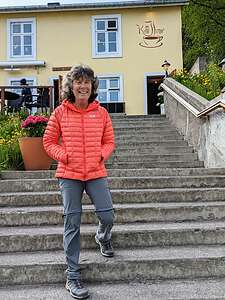 Birthday lunch timeI doubt I was going to be able to compete with Paul’s birthday bash yesterday, but I’d give it a try.
Birthday lunch timeI doubt I was going to be able to compete with Paul’s birthday bash yesterday, but I’d give it a try.
We weren’t quite sure yet we would end up this evening, but we did know that we were going to take another detour off the Ring Road up the highly scenic Trollaskagi Peninsula, with its beautiful mountains, fjords, and fishing villages.
I had my sights on one place in particular - Siglufjordur, considered to be one of the nicest fishing villages in Iceland.
But first we would pass through Akureyri “Iceland’s second largest city” and the “Capital of the North,” where I planned to have my birthday lunch.
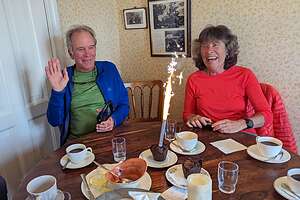 Kaffi IlmurActually, even before that we would literally pass through the Vadlaheidi Tunnel, a 7.5 km (4.7 miles) long tunnel that bypasses the precipitous Vikurskard Mountain Passage and brings you safely into Akureyri from the east.
Kaffi IlmurActually, even before that we would literally pass through the Vadlaheidi Tunnel, a 7.5 km (4.7 miles) long tunnel that bypasses the precipitous Vikurskard Mountain Passage and brings you safely into Akureyri from the east.
There is a toll for driving through this tunnel, which can only be paid online. If you pay within 3 hours the price is 1, 500 IS K (about $11), but if you procrastinate and pay later than that it is 2.500 ISK ($19). We paid right away.
Now, back to Akureyri. While Akureyri, population 19,000, truly is Iceland’s second largest city, there is a big gap with Reykjavik, which has 140,000 residents.
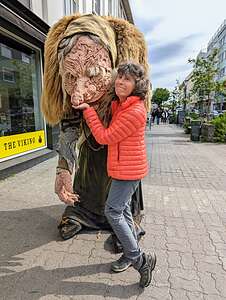 Troll of HafnarstraetiAnywhere else in the world it would be considered a town, but in Iceland it was a city.
Troll of HafnarstraetiAnywhere else in the world it would be considered a town, but in Iceland it was a city.
In many ways it had all the benefits of a city - great restaurants, cozy coffee shops, a colorful nightlife scene, beautiful street art, and local festivals - but without the downsides of traffic, crime, etc.
In doing so, it has become one of the “must see” destinations in Iceland, especially for those traveling around the Ring Road.
After poring through reviews, I chose to celebrate my birthday at Kaffi Ilmur, a small cafe and restaurant in one of Akureyri’s oldest houses.
Built in 1911, originally as a saddler’s shop, it later became a goldsmith’s, overlooking the fjord before the land was extended and more shops were built.
In 2011, one hundred years after it was built, the original saddler’s granddaughter (one of the Ingmars) opened it as a cafe.
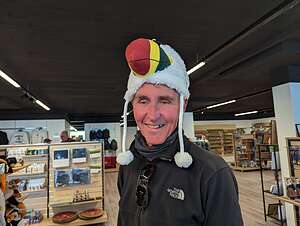 Doing some shoppingIn May 2022, the café was sold to new owners, but they have kept the decor and traditions the same.
Doing some shoppingIn May 2022, the café was sold to new owners, but they have kept the decor and traditions the same.
It was very quaint and cozy (just the way I like it), with the original walls and furniture, and a collection of photos of the original inhabitants of the house on one of the walls upstairs.
We could almost imagine that we were back in the 1900s eating in the Ingmar’s home.
The owner must have overheard that it was my birthday and after we finished our lunch, she brought out two delicious chocolate cupcakes, one topped with quite an exciting candle
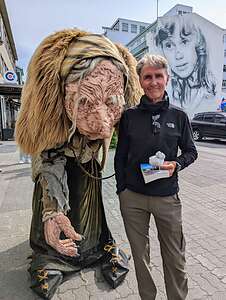 Souvenir successWarmth and hospitality lives on in the Ingmar’s dining room.
Souvenir successWarmth and hospitality lives on in the Ingmar’s dining room.
After lunch we strolled along Hafnarstraeti, the main drag through this lovely town - excuse me, “city” - lined with cafes, restaurants, galleries, street art, shops, and even a troll.
Trolls are a very important part of Iceland’s culture and folklore. They live in rocky mountains and caves (if they haven't been transformed into sea stacks). They like the taste of flesh and are known to lure unsuspecting humans into their caves with spells, magic potions or simply by taking them captive. He certainly had captivated me. I was ready to go back to his cave.
Every trip we try to buy a souvenir that is somewhat meaningful. Living in Northern California, I didn’t want or need one of those Icelandic sweaters, or a silly puffin hat (although Herb did look quite cute in one), so I chose a cute little sheep and the book Independent People about sheep farmers in early 1900s Iceland instead. They both now live on my bookshelf.
Goðafoss
Wednesday, June 7, 2023 - 9:45am by Lolo32 miles and 0.75 hours from our last stop
Travelogue
.thumbnail.jpg) Beautiful GodafossOur next stop along the Ring Road was Goðafoss, considered one of Iceland’s most beautiful waterfalls. It is located in northern Iceland just off the Ring Road at the junction with the Sprengisandur highland road, making it also one of the most accessible.
Beautiful GodafossOur next stop along the Ring Road was Goðafoss, considered one of Iceland’s most beautiful waterfalls. It is located in northern Iceland just off the Ring Road at the junction with the Sprengisandur highland road, making it also one of the most accessible.
There are two parking lots - one of the west side of the falls and one on the east, with a pedestrian bridge connecting the two. We parked on the west and hiked to the top and then went back, crossed over the pedestrian bridge to he east and hiked along that shore. Each side had a different perspective of the falls.
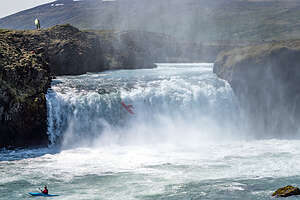 Kayaker takes the plungeThe waterfalls we had seen so far were one narrow cascade of water, but this one was much wider (98 feet) with multiple cascades.
Kayaker takes the plungeThe waterfalls we had seen so far were one narrow cascade of water, but this one was much wider (98 feet) with multiple cascades.
It is fed by the river Skjálfandafljót, the 4th largest river in Iceland, which runs in a 7000-year-old lava field from the Trölladyngja volcano.
The waterfall is absolutely stunning, and of course when we arrived, there was a beautiful rainbow across its spray.
We had come to expect rainbows in the spray of Iceland’s waterfalls, but this time we were treated to something else much more surprising - kayayers, plunging over the edge, disappearing in the spray, and then popping right side up at the base of the falls.
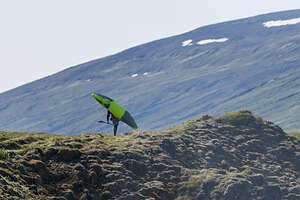 So much fun, let's try againWow! These guys were crazy! We could have watched and photographed them for hours.
So much fun, let's try againWow! These guys were crazy! We could have watched and photographed them for hours.
Besides being beautiful and exciting for kayakers, this waterfall plays a very important role in how Iceland became a Christian nation.
But for that, we have to go back in time to the year 1000 AD.
An old Icelandic saga tells the tale of the waterfall's name through a Viking leader named Þorgeir Ljósvetningagoði.
.thumbnail.jpg) Another takes the plungeFor the Icelandic people, sagas are not only the history of their medieval and Viking past, but entertaining stories passed from generation to generation. They are an extremely important part of their culture.
Another takes the plungeFor the Icelandic people, sagas are not only the history of their medieval and Viking past, but entertaining stories passed from generation to generation. They are an extremely important part of their culture.
Many of the sagas date from Iceland’s pagan, pre-Christian past, and that is exactly where the story of Goðafoss comes in.
In the year 1000, Iceland was still a pagan land when a local chieftain, named Þorgeir Ljósvetningagoði, was given the difficult task of making the crucial decision as to whether Iceland should remain pagan or convert to Christianity, as King Olaf of Norway was pressuring them to do.
As the story goes, Þorgeir withdrew to lay under a fur blanket for two nights before emerging with his decision to convert to Christianity. I think all political decisions should be made this way.
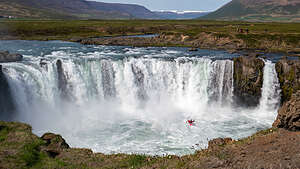 Celebration or relief?He then proceeded to throw all his statues of the Pagan gods into the waterfall. Thus Christianity became the official religion in Iceland in the year 1000 without bloodshed.
Celebration or relief?He then proceeded to throw all his statues of the Pagan gods into the waterfall. Thus Christianity became the official religion in Iceland in the year 1000 without bloodshed.
That is why this waterfall is named Godafoss, which means the “Waterfall of the Gods.”
Another theory is that it is called Godafoss because its beauty is godlike. That works for me.
Lake Mývatn Geothermal Area
Monday, June 5, 2023 - 6:15pm by Lolo130 miles and 2.5 hours from our last stop - 2 night stay
Travelogue
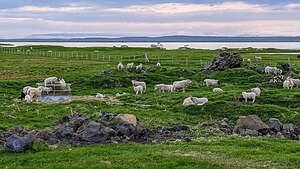 View from our campgroundWe had had a pretty long-driving day yesterday, and today it looked like we would have another. Our plan for the next two nights was to stay at the family-run Vogafjos Farm on the eastern shore of Lake Mývatn.
View from our campgroundWe had had a pretty long-driving day yesterday, and today it looked like we would have another. Our plan for the next two nights was to stay at the family-run Vogafjos Farm on the eastern shore of Lake Mývatn.
As we head west along the northern section of the Ring Road, I was so surprised how desolate and devoid of services it was. Good thing we had a full tank of gas, because there was really nothing along this section of road.
This would be the first time since leaving Reykjavik that we would stay two nights in one place, but there was an awful lot to do here - it sort of a mini Yellowstone, with lots of geothermal activity. Plus, we could use the rest.
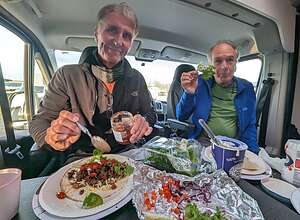 Dinner in the van tonightThere are several campgrounds in the Lake Mývatn area, but I chose Vogafjos Farm because of their farm-to-table restaurant. It was Paul’s birthday tomorrow, so I thought it would be a nice treat.
Dinner in the van tonightThere are several campgrounds in the Lake Mývatn area, but I chose Vogafjos Farm because of their farm-to-table restaurant. It was Paul’s birthday tomorrow, so I thought it would be a nice treat.
When we were checking in, I was a little concerned with the swarm of midges that were surrounding us. Lake Mývatn means mý ("midge") and vatn ("lake"); in other words, the lake of midges") due to the large numbers of midges present in the summer.
I really, really hoped they wouldn’t be a problem as I was very much looking forward to this stop.
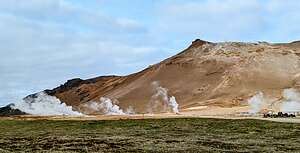 Hverir Geothermal AreaWe got in too late to really do anything tonight, so we just walked from our campsite over to the farm, and visited the lambs in the field and the cows in the cowshed.
Hverir Geothermal AreaWe got in too late to really do anything tonight, so we just walked from our campsite over to the farm, and visited the lambs in the field and the cows in the cowshed.
Oh, and we also peeked into the restaurant. It looked really nice and quite crowded, so we made reservations for the following night.
So, tonight it was dinner in the camper van - ground beef and veggie tortillas, a nice break from Herb’s pylsurs.
.thumbnail.jpg) Hverir geothermal areaThen off to bed because tomorrow was going to be a busy one - exploring and hiking through many of Lake Mývatn's geothermal areas, soaking in the Lake Mývatn Geothermal Spa , and concluding with Paul’s Birthday bash at the Vogafjós Farm Resort.
Hverir geothermal areaThen off to bed because tomorrow was going to be a busy one - exploring and hiking through many of Lake Mývatn's geothermal areas, soaking in the Lake Mývatn Geothermal Spa , and concluding with Paul’s Birthday bash at the Vogafjós Farm Resort.
The Hverir geothermal area is an extremely popular destination, so in order to avoid the crowds, we got there by 8:00 am and were the first ones in a very large parking lot.
.thumbnail.jpg) Hverir geothermal areaHverir, which means “hot springs” in Icelandic, is a high-temperature geothermal area with boiling, hissing, and bubbling fumaroles (steam vents) and solfataras (mud pots).
Hverir geothermal areaHverir, which means “hot springs” in Icelandic, is a high-temperature geothermal area with boiling, hissing, and bubbling fumaroles (steam vents) and solfataras (mud pots).
There is a loop trail along a boardwalk that brings you close to the geothermal features. Unlike Yellowstone, there were no fences or barriers of any sort.
.thumbnail.jpg) Herb near an old boreholeAlthough there are no geysers here, there were lots of steaming fumaroles. Fumaroles are vents in the Earth’s surface that emit hot volcanic steam and gases, including carbon dioxide, sulfur dioxide, hydrogen sulfide, hydrogen chloride, and hydrogen fluoride.
Herb near an old boreholeAlthough there are no geysers here, there were lots of steaming fumaroles. Fumaroles are vents in the Earth’s surface that emit hot volcanic steam and gases, including carbon dioxide, sulfur dioxide, hydrogen sulfide, hydrogen chloride, and hydrogen fluoride.
The gas and heat here are generated approximately 1,000 meters below the surface, where the temperature is above 200°C (392°F). Cold groundwater seeps down to magma intrusions, where it is superheated and returns to the surface with the gas.
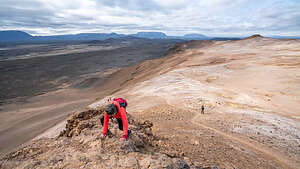 Climbing up Mt. NámafjallHerb found a rock pile which was placed over an old borehole. The steam coming from it was so massive that he kept disappearing in and out of the steam. Boreholes are drilled to use geothermal water for electricity production and the construction of heating plants. Sometime I like to call Herb an old "borehole."
Climbing up Mt. NámafjallHerb found a rock pile which was placed over an old borehole. The steam coming from it was so massive that he kept disappearing in and out of the steam. Boreholes are drilled to use geothermal water for electricity production and the construction of heating plants. Sometime I like to call Herb an old "borehole."
The whole area is very colorful with yellow, orange, pink, white, and gray. Yellow, which comes from the sulfur dioxide deposits, is the dominant color.
.thumbnail.jpg) Along the Mt. Námafjall hikeAs with all geothermal areas, there was an overwhelming smell of rotten eggs, which comes from the hydrogen sulfide
Along the Mt. Námafjall hikeAs with all geothermal areas, there was an overwhelming smell of rotten eggs, which comes from the hydrogen sulfide
This area has been nicknamed “eldhús djöfulsins” or Hell’s Kitchen. With the rising steam, bubbling pots, and rotten egg smell, it’s easy to see why.
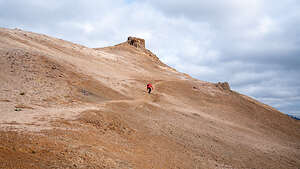 Climbing Mt. NámafjallFrom the boardwalk, we followed a trail up to the summit of an orange-colored rhyolite mountain called Námafjall, where the views from the top were supposed to be worth the climb.
Climbing Mt. NámafjallFrom the boardwalk, we followed a trail up to the summit of an orange-colored rhyolite mountain called Námafjall, where the views from the top were supposed to be worth the climb.
We didn’t realize it at the time, but the trail begins either in the northwest (right) or the southwest (left) corner of the base of Namafjall.
Unknowingly we went up the left side, which was much steeper, and went clockwise around the mountain. At least, going back down was much easier.
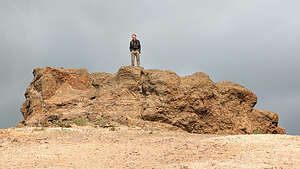 Herb at the topAt one point the trail was so steep and slippery with scree (loose stones) that many people turned back. Undaunted (well, maybe a little daunted), we forged on to the top - and we were probably the oldest people on the trail.
Herb at the topAt one point the trail was so steep and slippery with scree (loose stones) that many people turned back. Undaunted (well, maybe a little daunted), we forged on to the top - and we were probably the oldest people on the trail.
From the summit there was a terrific view of the Hverir geothermal area below in one direction and Lake Myvatn and more steaming fumaroles in the other.
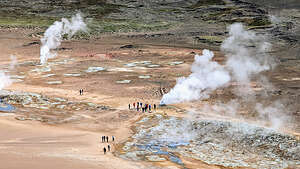 View of Hverir from the top of Mt. NámafjallThe trail down would have been a whole lot easier going up than the one went up, but I’m glad we did it the challenging way.
View of Hverir from the top of Mt. NámafjallThe trail down would have been a whole lot easier going up than the one went up, but I’m glad we did it the challenging way.
The parking lot was now quite full and the Hverir geothermal area, which we had pretty much had to ourselves an hour ago, was now teeming with tourists. So glad we got here first.
From Hverir, we took a short drive to the Krafla volcanic area, situated atop the Mid-Atlantic Ridge, where the North American and Eurasian plates meet. The Krafla volcano last erupted in 1984 and is considered an active volcano. Hopefully, today wouldn’t be the day.
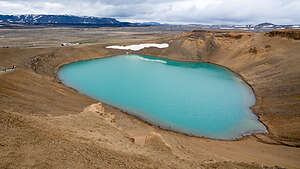 Viti CraterThe Viti Crater was formed in 1724 by a massive eruption that lasted 5 years. Its brilliant aqua blue water is due to elements brought up from the geothermal activity in the area.
Viti CraterThe Viti Crater was formed in 1724 by a massive eruption that lasted 5 years. Its brilliant aqua blue water is due to elements brought up from the geothermal activity in the area.
From the trail around the Viti Crater we could see the Krafla Geothermal Station (the largest power plant in Iceland).
I don’t totally understand it, but generating geothermal electricity works something like this:
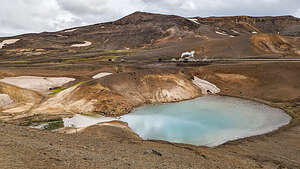 Geothermal Plant behind Viti CraterThermal energy emitted from the Earth’s core heats up water seeping down from the surface into magma chambers. Formed steam, flowing up, is then withdrawn to the turbines which converts the steam into electricity. Steam is then condensed into water and reinjected back to the Earth, closing the water cycle. This particular power plant produces 500 GWh of electricity.
Geothermal Plant behind Viti CraterThermal energy emitted from the Earth’s core heats up water seeping down from the surface into magma chambers. Formed steam, flowing up, is then withdrawn to the turbines which converts the steam into electricity. Steam is then condensed into water and reinjected back to the Earth, closing the water cycle. This particular power plant produces 500 GWh of electricity.
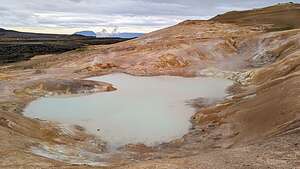 Along the Leirhnjukur lava field trailIceland generates over 99% of its electricity from renewable sources, namely hydroelectricity and geothermal.
Along the Leirhnjukur lava field trailIceland generates over 99% of its electricity from renewable sources, namely hydroelectricity and geothermal.
Today, 90% of homes and buildings are connected to district heating powered by geothermal, and the other 10% are heated with electricity generated from hydro and geothermal power.
Despite its natural beauty, the bright blue lake you see near the geothermal station is actually wastewater from the power plant. The source of its absolutely stunning color is a mineral in the wastewater called silica.
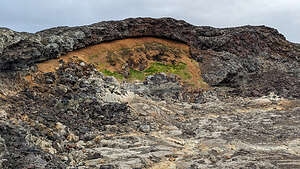 Crater along the Leirhnjukur trailI hate to give away any secrets, but the amazingly beautiful water in the famous Blue Lagoon Spa is also wastewater from a nearby geothermal plant. But more on that in a much later stop.
Crater along the Leirhnjukur trailI hate to give away any secrets, but the amazingly beautiful water in the famous Blue Lagoon Spa is also wastewater from a nearby geothermal plant. But more on that in a much later stop.
After the Viti Crater, we decided to hike the 2.5-mile trail through the lava fields of nearby Leirhnjukur, part of the Krafla volcano that erupted in 1984, creating lots and lots of lava. It is still a very active volcano.
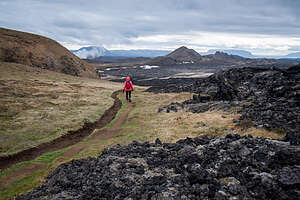 Path through the Leirhnjukur lava fieldBefore getting to the lava fields, we came upon a beautiful aqua-colored hot spring. In the distance you can see the smoke coming from the Krafla Geothermal station.
Path through the Leirhnjukur lava fieldBefore getting to the lava fields, we came upon a beautiful aqua-colored hot spring. In the distance you can see the smoke coming from the Krafla Geothermal station.
From there we continued on the marked paths around the lava fields. You’re not supposed to stray from the marked trails, because the lava field is still producing heat.
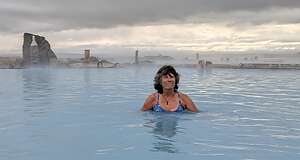 Mývatn Nature BathsThis lava was jet black, meaning it was from a recent lava flow and still hot.
Mývatn Nature BathsThis lava was jet black, meaning it was from a recent lava flow and still hot.
Enough with all this hiking through volcanic terrain. Time to celebrate Paul’s birthday at the Myvatn Geothermal Spa, with water as blue as the Blue Lagoon, and magnificent views of the surrounding steaming fumaroles. And it’s ¼ the price (after our senior discount).
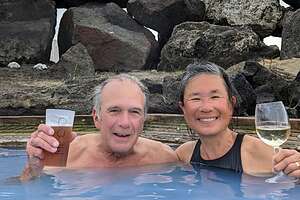 Birthday boyI was very much looking forward to these thermal baths, even more so than the Blue Lagoon, which we planned to do at the end of our trip. These seemed much less commercialized, much less crowded, and surrounded by a more natural setting of steaming fumaroles from the nearby Hverir Geothermal Area.
Birthday boyI was very much looking forward to these thermal baths, even more so than the Blue Lagoon, which we planned to do at the end of our trip. These seemed much less commercialized, much less crowded, and surrounded by a more natural setting of steaming fumaroles from the nearby Hverir Geothermal Area.
However, that beautiful milky blue water does not occur naturally, but rather is the result of minerals such as silica, in the wastewater of Geothermal Plants. In the case of the Myvatn Nature Baths, the water supplies for the lagoon run straight from the National Power Company's borehole in Bjarnarflag just a mile north.
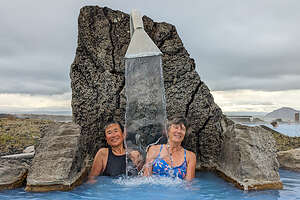 Hilda and I under an artificial "foss"When the water from the borehole arrives at the Nature Baths, it is about 130°C (266°F), so it has to be stored in a huge basin beside the lagoon to cool off for a while. I actually wandered over there at one point, thinking it was another pool to go in, but it was gated off.
Hilda and I under an artificial "foss"When the water from the borehole arrives at the Nature Baths, it is about 130°C (266°F), so it has to be stored in a huge basin beside the lagoon to cool off for a while. I actually wandered over there at one point, thinking it was another pool to go in, but it was gated off.
The water in the various pools in the lagoon are between 97 and 104°F, which is very comfortable and relaxing.
After paying our very reasonable $25 admission (senior discount!!), Hilda and I headed towards the women’s showers and Herb and Paul appropriately went to the men’s.
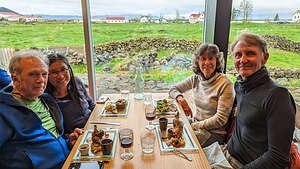 Dinner at the Vogafjós Farm ResortAfter going through the process of showering, putting our stuff in lockers, removing any silver or brass jewelry (because the sulfur in the water can turn them black), we reunited with the guys in one of the pools.
Dinner at the Vogafjós Farm ResortAfter going through the process of showering, putting our stuff in lockers, removing any silver or brass jewelry (because the sulfur in the water can turn them black), we reunited with the guys in one of the pools.
Then Paul’s birthday celebration began, which included a glass of wine from the lagoon-side bar. Not bad. My birthday was tomorrow, but Paul’s was going to be hard to beat.
We spent about two very relaxing hours in the thermal baths before heading back to camp to get ready for dinner.
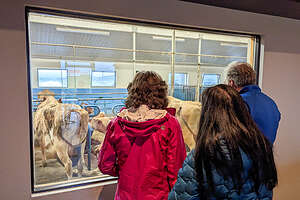 Window to cowshed on the other side of the restaurantNo powdered potatoes in the van for us tonight. Instead, we had dinner at the nearby Vogafjós Farm Resort, where local farm-to-table food is served.
Window to cowshed on the other side of the restaurantNo powdered potatoes in the van for us tonight. Instead, we had dinner at the nearby Vogafjós Farm Resort, where local farm-to-table food is served.
I thought it was a little bad form that Herb and Paul ordered the lamb shank while watching the cute little sheep wander past our window.
Glad we had the farm view. The other side of the restaurant had a glass window separating it from the cowshed.
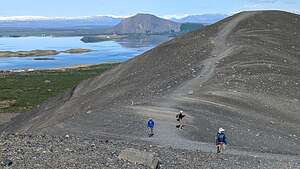 Hverfjall Crater HikeThat's a little too farm-to-table for me. Hilda and I had the delicious “sea”-to-table Artic Char
Hverfjall Crater HikeThat's a little too farm-to-table for me. Hilda and I had the delicious “sea”-to-table Artic Char
There is really so much to do in the Lake Myvatn area that we could easily have spent a few more days here. In fact, the next morning we decided to squeeze in just one more volcanic hike before continuing along the Ring Road.
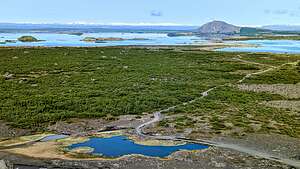 Hverfjall Crater HikeThis time we decided to hike to the top of the 1,300-foot high Hverfjall Crater, a massive black ash tephra cone, or tuff ring volcano.
Hverfjall Crater HikeThis time we decided to hike to the top of the 1,300-foot high Hverfjall Crater, a massive black ash tephra cone, or tuff ring volcano.
It last erupted 4,500 years ago. It is considered a high tephra explosion crater because of the massive amounts of ash and volcanic rock that it blasted all over the area.
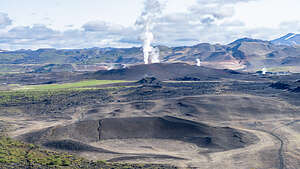 Hverfjall Crater HikeThe crater is a full kilometer wide and about 140 meters (460 feet) deep. It is dark and has a beautiful almost perfectly circular shape, like a stadium or an amphitheater.
Hverfjall Crater HikeThe crater is a full kilometer wide and about 140 meters (460 feet) deep. It is dark and has a beautiful almost perfectly circular shape, like a stadium or an amphitheater.
It was a fairly steep trail, with an elevation gain of about 700 feet, to get up to the rim from the parking lot. From there, we started walking counter-clockwise around the rim.
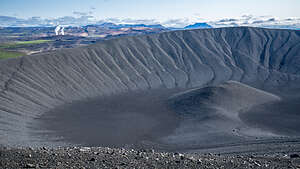 Hverfjall Crater HikeFrom the rim, we could look out towards lovely Lake Myvatn on one side, and the ubiquitous steam rising from the earth on the other.
Hverfjall Crater HikeFrom the rim, we could look out towards lovely Lake Myvatn on one side, and the ubiquitous steam rising from the earth on the other.
I’ve never thought of a crater as pretty or elegant before, but this one was both.
Looking down into the crater, we saw a large mound in the middle. Not all craters have these, only those in which the impact was powerful enough to form what is known as a central peak, made from debris that flowed like a fluid and then solidified into a mound in the middle of the crater.
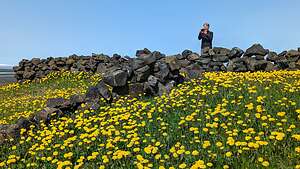 Yellow wildflowers near an 1880s sheepfoldFrom there, we continued along the rim and then down the steep trail to the parking lot, which now had a few cars and a small tour bus. Once again, being the first one on a hike, as we were this morning, is always more special.
Yellow wildflowers near an 1880s sheepfoldFrom there, we continued along the rim and then down the steep trail to the parking lot, which now had a few cars and a small tour bus. Once again, being the first one on a hike, as we were this morning, is always more special.
As we were leaving the Lake Myvatn area we pulled over to admire a field of beautiful yellow wildflowers surrounded by fences built from piled up black lava rock.
It turned out to be what’s called a sheepfold and it was built in 1880.I’ve become pretty obsessed about sheep this trip. They are almost as cute as puffins, in their own wooly way. I’m even reading a book about the life of a rural of
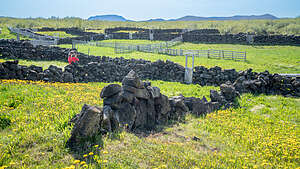 An 1880s SheepfoldIn early summer, the farmers let their sheep graze in the highland pastures north and east of Myvatn. In autumn they would gather the sheep again and drive them into the main compartment (double row of lava stone) of this sheepfold. Every sheep is marked by its owner’s earmark enabling him to identify it and move it into his individual compartment of the sheepfold.
An 1880s SheepfoldIn early summer, the farmers let their sheep graze in the highland pastures north and east of Myvatn. In autumn they would gather the sheep again and drive them into the main compartment (double row of lava stone) of this sheepfold. Every sheep is marked by its owner’s earmark enabling him to identify it and move it into his individual compartment of the sheepfold.
I was so excited because I was currently reading Independent People, which is about sheep farmers in Iceland in the early 1900s, and I was coincidentally up to the part where they all went out sheep gathering to collect and separate their sheep for the winter. I really am a nerd.
Ok, so now it was really time to move on. Next stop, Godafoss, one of the most beautiful waterfalls in Iceland.
Hengifoss
Monday, June 5, 2023 - 10:00am by Lolo70 miles and 1.5 hours from our last stop
Travelogue
 Hike to Litlanesfoss and HengifossWe got a bit off schedule with our detour to Borgarfjörður Eystri (but it was so worth it!), so it was going to be mostly a driving day with one fun stop along the way - a hike to the beautiful Hengifoss waterfall.
Hike to Litlanesfoss and HengifossWe got a bit off schedule with our detour to Borgarfjörður Eystri (but it was so worth it!), so it was going to be mostly a driving day with one fun stop along the way - a hike to the beautiful Hengifoss waterfall.
We were only back on the Ring Road for 5 miles before turning south on Road 931, and driving for 20 miles along the shores of Lagarfljót Lake to the trailhead for Hengifoss. It was a bit more of an out-and-back than I previously thought.
 Approaching LitlanesfossAs with many places in Iceland, there is a legend associated with this lake. Rocks, mountains, lakes, etc., all seem to have magical creatures (elves, trolls, monsters) either living in them or being turned into them. In this case, it's a large heath-worm (black slug).
Approaching LitlanesfossAs with many places in Iceland, there is a legend associated with this lake. Rocks, mountains, lakes, etc., all seem to have magical creatures (elves, trolls, monsters) either living in them or being turned into them. In this case, it's a large heath-worm (black slug).
But before we get to the legend of the heath-worm, let’s get to the reason we were here in the first place - the hike to the lovely waterfall known as Hengifoss.
 Lovely LitlanesfossThe hike to Hengifoss is one of the most popular hikes in East Iceland, so by the time we got to the trailhead, the parking lot was already quite full.
Lovely LitlanesfossThe hike to Hengifoss is one of the most popular hikes in East Iceland, so by the time we got to the trailhead, the parking lot was already quite full.
From the parking lot, we began walking up a steady, but gradual hill, with a peaceful bucolic view of farmland and the river Hengifossá behind us.
At a little less than a mile we came to the first waterfall, Litlanesfoss, notable for the beautiful basalt columns surrounding it, like layers of thick curtains. These basalt columns are 15 to 20 meters high, making them the highest basalt columns in Iceland.
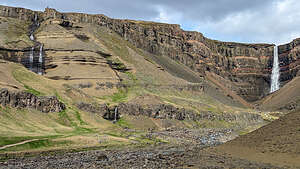 Approaching HengifossThis waterfall alone would have been worth the hike, but it is unfortunately overshadowed by its more impressive neighbor, Hengifoss.
Approaching HengifossThis waterfall alone would have been worth the hike, but it is unfortunately overshadowed by its more impressive neighbor, Hengifoss.
We continued on for about another ¾ of a mile to the beautiful and unique Hengifoss, known for its distinctive alternating layers of volcanic bedrock interlaced with beds of bright red mud and ash deposits.
As the falls have carved out the canyon, the ash deposits have become conspicuously exposed, resulting in nearly a dozen very vivid stripes of red earth running perpendicular to the falls across the darker cliff face.
.thumbnail.jpg) HengifossAt 128 meters high, it is also the third highest waterfall in Iceland.
HengifossAt 128 meters high, it is also the third highest waterfall in Iceland.
On the hike down, we had a choice of retracing our steps or veering off to the left when we came to a bridge. We chose to see something new and I am so glad we did.
About a third of the way down, we came to an amazing collection of basalt columns. Because of frequent volcanic activity, Iceland has more basalt column sites than any other place on the planet, and we had seen many, but none as impressive as these.
 Hengifoss up closeBasaltic columns such as these have inspired architects in Iceland, as we saw in the exterior of the beautiful Hallgrímskirkja in Reykjavik.
Hengifoss up closeBasaltic columns such as these have inspired architects in Iceland, as we saw in the exterior of the beautiful Hallgrímskirkja in Reykjavik.
Okay, now for the Legend of the giant heath-worm of Lagarfljót Lake.
As legend has, a little girl was given a gold ring by her mother, who told her to place it under a heath-worm so that the gold would multiply. She did as her mother said, but when she checked back on it a few days later, she found that the worm had grown so large that it had broken open the chest she had placed it in.
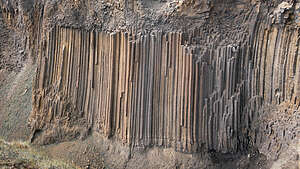 Incredible basalt columns on the hike downTerrified, she threw the worm and the gold into the lake, where it continued to grow, terrorizing the countryside, killing people and animals and spitting poison onto the farmlands. This was not a nice worm.
Incredible basalt columns on the hike downTerrified, she threw the worm and the gold into the lake, where it continued to grow, terrorizing the countryside, killing people and animals and spitting poison onto the farmlands. This was not a nice worm.
Two Finnish magicians were commissioned to destroy it and retrieve the gold. However, all they managed to do was to tie its head and tail to the bottom of the lake, only allowing it to arch its back above the lake’s surface. If the worm ever manages to get lose, not only will it cause trouble again, but it will bring about the end of the world.
Well isn't that cheery.
Borgarfjörður eystri
Sunday, June 4, 2023 - 6:00pm by Lolo60 miles and 1.5 hours from our last stop - 1 night stay
Travelogue
 Campsite view - Álfaborg, home of the elvesOriginally we thought we would camp in Seydisfjordur, but that was before we added Borgarfjörður eystri, home to one of the largest puffin colonies in Iceland, to our already packed itinerary.
Campsite view - Álfaborg, home of the elvesOriginally we thought we would camp in Seydisfjordur, but that was before we added Borgarfjörður eystri, home to one of the largest puffin colonies in Iceland, to our already packed itinerary.
We really wanted to see puffins (other than on a menu), and that was pretty much a guarantee at Borgarfjörður eystri, where 10,000 pairs of puffins nest every year between April and August.
.thumbnail.jpg) Borgarfjörður eystri fishing villageThe best time of the day to see puffins is between 7:00 and 10:00 in the morning when they are getting ready for a day of fishing out at sea, and then again in the evening between 6:00 and 10:00 when they return to their burrows.
Borgarfjörður eystri fishing villageThe best time of the day to see puffins is between 7:00 and 10:00 in the morning when they are getting ready for a day of fishing out at sea, and then again in the evening between 6:00 and 10:00 when they return to their burrows.
Camping near there would provide us with a chance to see them both times in the evening and then the following morning.
 Marina with puffin colony behindSo, well left Seydisfjordur and drove back up the winding Road 93 towards Egilsstaðir, and then turned onto 94 which took us up and over some more mountains before coming to the end of the road in Borgarfjörður eystri, where the puffins nest. It was about an hour and a half drive.
Marina with puffin colony behindSo, well left Seydisfjordur and drove back up the winding Road 93 towards Egilsstaðir, and then turned onto 94 which took us up and over some more mountains before coming to the end of the road in Borgarfjörður eystri, where the puffins nest. It was about an hour and a half drive.
This was by far our longest driving day to date - over four and a half hours (from Vestrahorn to here) rather than our leisurely two. But, as we would find out, it was definitely worth it.
 Puffins in their burrowBorgarfjörður eystri is a quaint little fishing village of 130 people, 20,000 puffins, and countless sheep. We checked into the only campground in town, the Borgarfjörður eystri Campsite, which was quite lovely, set at the foot of a rocky hill called Álfaborg, which the campground website claimed was home to elves. Fortunately, the website added that the elves don't mind guests as long as they respect their home, the rocks. Ok, got it. I would have been much more worried if it was inhabited by trolls.
Puffins in their burrowBorgarfjörður eystri is a quaint little fishing village of 130 people, 20,000 puffins, and countless sheep. We checked into the only campground in town, the Borgarfjörður eystri Campsite, which was quite lovely, set at the foot of a rocky hill called Álfaborg, which the campground website claimed was home to elves. Fortunately, the website added that the elves don't mind guests as long as they respect their home, the rocks. Ok, got it. I would have been much more worried if it was inhabited by trolls.
 Marital spat?I’ve seen various statistics of what percentage of Icelandic people believe in elves, and it varies from just under 50% to up to 80%. Even those that don’t believe in them are hesitant to deny their existence, respect the traditions and myths surrounding them, and tread lightly when entering elf territory, just in case.
Marital spat?I’ve seen various statistics of what percentage of Icelandic people believe in elves, and it varies from just under 50% to up to 80%. Even those that don’t believe in them are hesitant to deny their existence, respect the traditions and myths surrounding them, and tread lightly when entering elf territory, just in case.
 Those wings flap 400 times per minuteWell, anyway, elves have great taste, because that mountain was stunning. Not sure, how the stranded boat near the base of their mountain got there. Perhaps the owners were disrespectful.
Those wings flap 400 times per minuteWell, anyway, elves have great taste, because that mountain was stunning. Not sure, how the stranded boat near the base of their mountain got there. Perhaps the owners were disrespectful.
We were pretty excited about seeing puffins, so almost immediately, we drove the short distance from the campground to the puffin colony, which is located on the grassy rock promontory behind the Hafnarhólmi marina.
 Tucking in for a landingBefore leaving the parking lot, we just had to spend some time watching the sheep playing in the field. Each ewe gives birth to two lambs at a time. The lambs are adorable and they roll around on each other and play like puppies. I think they would be great pets. Just think of the sweaters!
Tucking in for a landingBefore leaving the parking lot, we just had to spend some time watching the sheep playing in the field. Each ewe gives birth to two lambs at a time. The lambs are adorable and they roll around on each other and play like puppies. I think they would be great pets. Just think of the sweaters!
 Morning commute back to the puffins colonyWe had to drag ourselves away to go see the puffins.
Morning commute back to the puffins colonyWe had to drag ourselves away to go see the puffins.
We walked up to the hill behind the marina, where there was a shelter and wooden viewing platforms where we could get really close to the puffins without damaging their burrows. We were separated from them by a fence, but still, we were really close.
 Along the way to the puffins colonyThis was definitely the place. There were hundreds of them right near us - coming in and out of their burrows, strutting around, mingling with each other, and most fun of all, flying in from a day at sea fishing for herring and sand eels.
Along the way to the puffins colonyThis was definitely the place. There were hundreds of them right near us - coming in and out of their burrows, strutting around, mingling with each other, and most fun of all, flying in from a day at sea fishing for herring and sand eels.
There are several species of puffins, but the ones in Iceland are Atlantic Puffins. In fact, Iceland is home to more Atlantic Puffins than any other country in the world.
 Playful lambsThey are beautiful birds, or at least they are during the breeding season (April through August) when they are trying to impress the ladies. It is only then that their bills turn a colorful reddish-orange, earning them the nicknames “sea parrot” and “clown of the sea.” As winter approaches the bright colors begin to fade.
Playful lambsThey are beautiful birds, or at least they are during the breeding season (April through August) when they are trying to impress the ladies. It is only then that their bills turn a colorful reddish-orange, earning them the nicknames “sea parrot” and “clown of the sea.” As winter approaches the bright colors begin to fade.
They live in underground burrows, which they dig using their bills and feet. They use their bills to cut into soil and then shovel away loose material with their feet. They like to make their burrows between rocks or on steep cliffs so predators can’t easily reach them.
 Off to workPuffins mate for life although they do not begin the mating process until they are 5 years old, just about the time when we humans start kindergarten.
Off to workPuffins mate for life although they do not begin the mating process until they are 5 years old, just about the time when we humans start kindergarten.
The female lays one egg and both parents take turns incubating the egg for about 40 days. Once the egg hatches, the puffling (the puffin chick) and the adults return to the sea.
Puffins spend most of their time out at sea living a solitary existence, and only return to the crowded, busy colonies during breeding season.
 Ready to start their day at seaPuffins are not only good swimmers, but they are also very fast fliers. They can flap their wings up to 400 times per minute and reach speeds of 50 mph. That speed made it very difficult for Herb to photograph them flying in for a landing. It was only after we got home and we reviewed the photos that we saw how awkward, and very amusing, they look when they come dive bombing in for a landing.
Ready to start their day at seaPuffins are not only good swimmers, but they are also very fast fliers. They can flap their wings up to 400 times per minute and reach speeds of 50 mph. That speed made it very difficult for Herb to photograph them flying in for a landing. It was only after we got home and we reviewed the photos that we saw how awkward, and very amusing, they look when they come dive bombing in for a landing.
.thumbnail.jpg) They are not exactly the most graceful fliersWe could have watched them for hours, but it was getting late and we had had a very busy day. I can’t believe that it was only this morning that we were wandering around a Viking Village.
They are not exactly the most graceful fliersWe could have watched them for hours, but it was getting late and we had had a very busy day. I can’t believe that it was only this morning that we were wandering around a Viking Village.
The next morning we couldn’t just leave Borgarfjörður Eystri without saying goodbye to our puffin friends, so we drove back to the puffin colony to observe their morning activities.
We ran into a bit of traffic on the way over.
This time we watched as they climbed out of their burrows and prepared for flight, spreading their wings and looking out to sea. Some of them didn't seem in too much of a hurry to get going. Also, I'm not sure if just one of the pair goes out to sea, while the other one stays near the burrow with the egg. In either case, it looked like a busy little community about to start their day.
 Gotta love them lambies thoughOnce again, we had to pull ourselves away from the puffins. Watching them can be very addictive. The sheep were pretty darn cute too!
Gotta love them lambies thoughOnce again, we had to pull ourselves away from the puffins. Watching them can be very addictive. The sheep were pretty darn cute too!
I saw an article online that the annual sheep round-up for Borgarfjörður Eystri is facing a labor shortage, due to both a dwindling population and the increasing age of the sheep farmers themselves, so they are asking for people to come out and help with the herding. I’m seriously thinking about it. They are so adorable.
Time to hit the road
Seydisfjordur
Sunday, June 4, 2023 - 11:00am by Lolo110 miles and 2.5 hours from our last stop
Travelogue
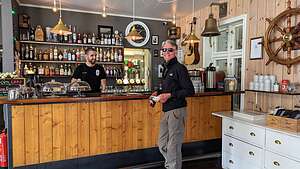 Herb in Kaffi LaraAfter leaving Djupivogur, we continued along the Ring Road (Route 1) towards the town of Egilsstaðir, where we would leave the Ring Road to take a side trip to the Seydisfjordur, considered to be one of the most beautiful villages in East Iceland.
Herb in Kaffi LaraAfter leaving Djupivogur, we continued along the Ring Road (Route 1) towards the town of Egilsstaðir, where we would leave the Ring Road to take a side trip to the Seydisfjordur, considered to be one of the most beautiful villages in East Iceland.
We weren’t very far from Djupivogur before Google Maps directed us onto a gravel road. This road didn’t seem right, so we stopped to look at the map. Google does this sometimes, picking a shorter distance route, regardless of road conditions.
Oh, this was the infamous road 939 that went over Öxi Pass that McRent had warned us about - “absolutely do not go on that road.”
.thumbnail.jpg) Iconic blue churchSo, we turned around and got back on the Ring Road, which weaved its way among the fjords - quite a bit longer, but much more scenic and safe.
Iconic blue churchSo, we turned around and got back on the Ring Road, which weaved its way among the fjords - quite a bit longer, but much more scenic and safe.
When we got to the town of Egilsstaðir, we left the Ring Road and turned onto Road 93 towards Seydisfjordur. This was quite a road, winding and climbing over a 2,000 foot mountain pass, with snow all around us. It felt like we had entered a winter wonderland.
We later found out that this is one of the highest paved roads in Iceland, and they are even thinking of building a tunnel through the mountain pass, as the road is often impassable in winter. The scenery certainly was beautiful though.
Before exploring the village, we stopped to have lunch at Kaffi Lara, a cozy restaurant and bar right near Rainbow Street. The food and ambience was great.
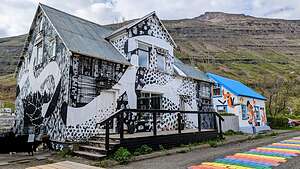 Street Art along the Rainbow RoadWe got to talking to our waiter who told us he was from Barcelona, but comes here to work in the summer. Summer is a relative term, as he said the town was totally cut off from the rest of Iceland until a few weeks ago because of snow, reinforcing that need for a tunnel through the mountain pass on 93.
Street Art along the Rainbow RoadWe got to talking to our waiter who told us he was from Barcelona, but comes here to work in the summer. Summer is a relative term, as he said the town was totally cut off from the rest of Iceland until a few weeks ago because of snow, reinforcing that need for a tunnel through the mountain pass on 93.
After lunch, we set out to explore the town, which we knew wouldn’t take very long because it is quite small, with only 700 inhabitants.
Our first stop was right outside our restaurant - the iconic Seydisfjordur blue church with a rainbow road leading towards it - just like Reykjavik's Rainbow Road leading towards Hallgrímskirkja, but on a much smaller scale. It’s a very popular spot to take a photograph, so we had to wait our turn.
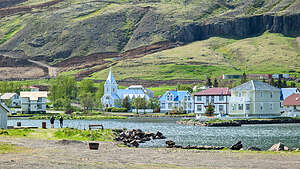 SeydisfjordurTiny Seydisfjordur is surprisingly one of Iceland's cultural centers and attracts artists from around the country. In addition, there is an art academy that attracts young people from across Iceland and abroad.
SeydisfjordurTiny Seydisfjordur is surprisingly one of Iceland's cultural centers and attracts artists from around the country. In addition, there is an art academy that attracts young people from across Iceland and abroad.
So with all these artists, as you would expect, the buildings along the Rainbow road were covered with murals.
The street is also lined with many bars and cafes, and it is one of the liveliest parts of Seydisfjordur.
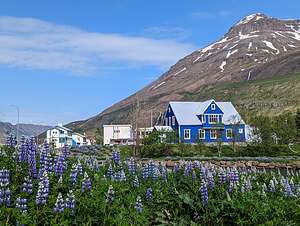 SeydisfjordurThe town has a nice harbor located at the innermost point of a 10-mile-long fjord. In the early 20th century it was a booming town of Norwegian-run herring fisheries, and many of the buildings survive from this time period. As herring stocks declined, so did the town.
SeydisfjordurThe town has a nice harbor located at the innermost point of a 10-mile-long fjord. In the early 20th century it was a booming town of Norwegian-run herring fisheries, and many of the buildings survive from this time period. As herring stocks declined, so did the town.
As with many other Icelandic villages, the economy of the town is now driven by tourism.
We took a stroll around the harbor admiring the colorful houses, backed by snow-capped mountains and cascading waterfalls. And the lupine! Lots and lots of beautiful bright blue lupine!
And all because of one man, Hákon Bjarnason, who back in 1945 was sent to Alaska as a representative of a committee set up to revegetate areas of Iceland. Guess what plant he picked. That’s right lupine, and today it covers and beautifies so much of Iceland. Thank you Hákon.
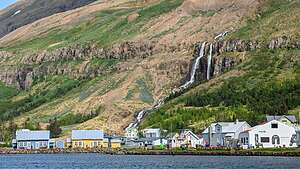 SeydisfjordurIn December of 2020, tragedy hit the village when some of those beautiful hills overlooking the town came tumbling down in a landslide, destroying more than 10 buildings.
SeydisfjordurIn December of 2020, tragedy hit the village when some of those beautiful hills overlooking the town came tumbling down in a landslide, destroying more than 10 buildings.
It was the most damaging landslide ever to hit a town in Iceland. The destruction and economic loss was enormous, but miraculously there were no casualties.
The townspeople came together in a massive clean-up and rebuild effort to save their beloved village.
Seydisfjordur definitely earns its distinction as the most beautiful village in East Island, as well as the most public-spirited and heroic.
Vestrahorn
Saturday, June 3, 2023 - 7:45pm by Lolo57 miles and 1.2 hours from our last stop - 1 night stay
Travelogue
 Herb meets VestrahornWhat a day it had already been with enough varied scenery to normally fill a week - sod-covered churches, a beautiful canyon hike to a waterfall, a glacier lagoon with icebergs bopping about, and a stunning beach covered in glittering ice.
Herb meets VestrahornWhat a day it had already been with enough varied scenery to normally fill a week - sod-covered churches, a beautiful canyon hike to a waterfall, a glacier lagoon with icebergs bopping about, and a stunning beach covered in glittering ice.
But it wasn’t over yet. In fact, the best was yet to come,
After Diamond Beach, we were pretty much leaving the touristy section of the Ring Road and heading into the more remote natural beauty of eastern Iceland.
 VestrahornWe had watched plenty of YouTube videos during our pre-trip planning and were very excited about visiting Vestrahorn, a stunning mountain with spiky peaks rising 1,490 feet above a flat, black sand beach with undulating dunes and giant tufts of grass.
VestrahornWe had watched plenty of YouTube videos during our pre-trip planning and were very excited about visiting Vestrahorn, a stunning mountain with spiky peaks rising 1,490 feet above a flat, black sand beach with undulating dunes and giant tufts of grass.
The locals call it “Batman Mountain,” because its spiky peaks (“horns”) look like the Batman logo.
 Tiny little Viking Village at base of mountainUnlike most of the mountains in Iceland, which are volcanic in origin, this one is made out of iron- and magnesium-rich gabbro rock, which leads to its dark and jagged appearance. The perfect setting for a Viking Village or an episode of Game of Thrones.
Tiny little Viking Village at base of mountainUnlike most of the mountains in Iceland, which are volcanic in origin, this one is made out of iron- and magnesium-rich gabbro rock, which leads to its dark and jagged appearance. The perfect setting for a Viking Village or an episode of Game of Thrones.
Since it’s located down an unmarked dirt road off the Ring Road, very few tourists come here - mostly just photographers that know about this spot. It's absolutely stunning.
 Across the beachTo get here, we passed the turnoff for the town of Höfn, and continued on the Ring Road for about 4 miles and made a right turn onto the unmarked dirt road immediately before a long dark tunnel.
Across the beachTo get here, we passed the turnoff for the town of Höfn, and continued on the Ring Road for about 4 miles and made a right turn onto the unmarked dirt road immediately before a long dark tunnel.
We continued on this road for about 2.5 miles before arriving at the Viking Cafe.
It was quite cozy and nice with lovely pastries and other baked goods for sale. They have a small campground there - basically two parking lots, one behind the cafe and one atop a nearby hill. We preferred the one up the hill because there were better views.
We booked camping for the night, which gave us free access out onto the Stokknes Peninsula where Vestrahorn is located. Otherwise, it costs $10.
 Shortcut along the tidal flatsAfter paying, we drove through the gate out onto a dirt road that brought us alongside the tidal flat and sand dunes. Clouds were moving in quickly, so he had to hurry if we wanted to catch the beautiful light that was still falling on Vestrahorn.
Shortcut along the tidal flatsAfter paying, we drove through the gate out onto a dirt road that brought us alongside the tidal flat and sand dunes. Clouds were moving in quickly, so he had to hurry if we wanted to catch the beautiful light that was still falling on Vestrahorn.
We parked in the first pullout we could find and ran out onto the grass-covered dunes for a striking view, and hopefully some striking photographs, of this amazing mountain.
 Getting closerLuckily we did, because we literally only had 10 minutes of sunlight on the mountain before the clouds darkened its face. Thank God, we didn’t stop for a pastry and coffee in the Cafe or we would have missed it.
Getting closerLuckily we did, because we literally only had 10 minutes of sunlight on the mountain before the clouds darkened its face. Thank God, we didn’t stop for a pastry and coffee in the Cafe or we would have missed it.
While Herb was rushing around trying to catch the fading light, Hilda and I noticed some tiny little structures at the base of the mountain, way over on the other side of the tidal flats. This must be the tiny Viking Village, which was the film set for a movie that never happened.
 Our Viking hostAdventurous women that we are, Hilda and I decided that we would try to get there. It turned out to be a lot more of an adventure than we expected.
Our Viking hostAdventurous women that we are, Hilda and I decided that we would try to get there. It turned out to be a lot more of an adventure than we expected.
So off we went across the grassy dunes towards the beach, where we occasionally sunk quite deeply in the sand. The reflections of Vestrahorn in the calm sea though were worth getting our sneakers wet.
The real trail went straight across the beach to the base of the mountain before turning left towards the Viking Village. We, however, decided to take a diagonal shortcut (the hypotenuse) across what we discovered a bit too late was a wet tidal marsh.
 Traditional Icelandic sod-covered homesWe weaved our way along the driest spots we could find and eventually made it to the Viking Village, dramatically set against the base of the massive Vestrahorn.
Traditional Icelandic sod-covered homesWe weaved our way along the driest spots we could find and eventually made it to the Viking Village, dramatically set against the base of the massive Vestrahorn.
The village is a replica of an authentic Viking village, created in 2010 as a movie set for a Universal Studios production, which never happened because of budgetary reasons. We had the whole place to ourselves and were able to wander amongst the various sod-roofed wooden structures, much like the traditional Icelandic turf houses. There was even a wood-carved Viking to greet us.
There was even a Viking ship that we could board and pretend that we were Vikings. Hilda beat me to the ship’s wheel and took command of the ship.
 Traditional Icelandic sod-covered homesWe had been gone for almost two hours already, so I texted Herb thinking he might be worried about us. When he didn’t respond after 20 minutes or so, I texted him again thinking I might get his attention with, “I met Thor in the Viking Village. Don’t wait up for me,” but even that didn’t get a response. Herb’s not the jealous type.
Traditional Icelandic sod-covered homesWe had been gone for almost two hours already, so I texted Herb thinking he might be worried about us. When he didn’t respond after 20 minutes or so, I texted him again thinking I might get his attention with, “I met Thor in the Viking Village. Don’t wait up for me,” but even that didn’t get a response. Herb’s not the jealous type.
After having enough fun playing Viking, Hilda and I continued on and back to the van, where the boys were happily drinking beer, totally unphased that we had been gone for two hours.
 Viking shipWe drove back out through the access gate and up the hill to our campsite for the night. The Viking Cafe was already closed (Vikings must go to bed early), so it was backpacking food for us in our camper - Idahoan powdered potatoes with Starkist chicken in a package mixed in. Oh, and Hilda made some cabbage so we would have a veggie.
Viking shipWe drove back out through the access gate and up the hill to our campsite for the night. The Viking Cafe was already closed (Vikings must go to bed early), so it was backpacking food for us in our camper - Idahoan powdered potatoes with Starkist chicken in a package mixed in. Oh, and Hilda made some cabbage so we would have a veggie.
We were pretty exhausted. It had been a very big day..
Jökulsárlón Glacier Lagoon and Diamond Beach
Saturday, June 3, 2023 - 2:30pm by Lolo10 miles and 0.25 hours from our last stop
Travelogue
 Jökulsárlón glacier lagoonThere is so much to see along the southern portion of the Ring Road that we didn’t have to drive too far before our next stop - The Jökulsárlón glacier lagoon, where 1,000-year-old, large blue, white, turquoise and black-streaked icebergs shift and bop about the lagoon, before breaking up and heading out to the sea through a narrow channel.
Jökulsárlón glacier lagoonThere is so much to see along the southern portion of the Ring Road that we didn’t have to drive too far before our next stop - The Jökulsárlón glacier lagoon, where 1,000-year-old, large blue, white, turquoise and black-streaked icebergs shift and bop about the lagoon, before breaking up and heading out to the sea through a narrow channel.
It is one of Iceland’s most popular destinations, and understandably so.
 Jökulsárlón Glacier LagoonThis lagoon is less than 100 years old. Located at the head of the Breiðamerkurjökull glacier, the lagoon was formed as the glacier warmed and began receding from the edge of the Atlantic Ocean.
Jökulsárlón Glacier LagoonThis lagoon is less than 100 years old. Located at the head of the Breiðamerkurjökull glacier, the lagoon was formed as the glacier warmed and began receding from the edge of the Atlantic Ocean.
As temperatures continue to rise, the lagoon continues to grow as the glacier recedes even further. Today the lagoon is four times larger than it was in the 1970s, making it the deepest lake in Iceland.
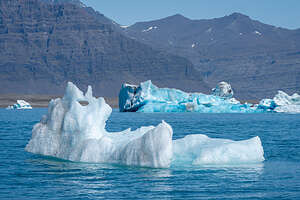 Jökulsárlón Glacier LagoonAs the glacier calves, it deposits icebergs into the lagoon. Eventually, these icebergs break up and when the chunks are small enough, they start floating across the lagoon towards the channel that connects it to the sea.
Jökulsárlón Glacier LagoonAs the glacier calves, it deposits icebergs into the lagoon. Eventually, these icebergs break up and when the chunks are small enough, they start floating across the lagoon towards the channel that connects it to the sea.
It was like watching the effects of global warming in real time.
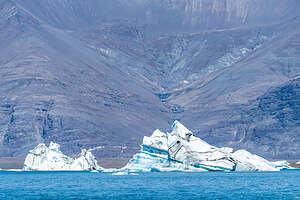 Jökulsárlón Glacier LagoonThere are two ways to spend your time at Jökulsárlón. You can take an amphibian or Zodiac boat ride to get up close and personal to the icebergs on the lagoon, or you can hike around the lagoon’s perimeter.
Jökulsárlón Glacier LagoonThere are two ways to spend your time at Jökulsárlón. You can take an amphibian or Zodiac boat ride to get up close and personal to the icebergs on the lagoon, or you can hike around the lagoon’s perimeter.
We chose to avoid the crowds and walk the trail along the shoreline.
As we strolled along the shore, I began wondering why some of the icebergs were a milky white and some a bright blue. The blue ones were absolutely beautiful.
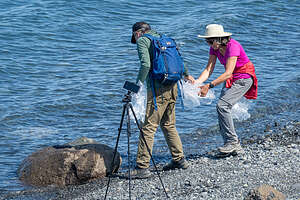 Harvesting Ice for Cocktail HourAs I often do, I turned to Google for the answer.
Harvesting Ice for Cocktail HourAs I often do, I turned to Google for the answer.
Blue icebergs are much older than white icebergs, originating from portions of a glacier that are very compressed and have fewer bubbles. The fewer the bubbles the less chance there is of light being scattered, resulting in red wavelengths being absorbed, with only blue light being scattered and escaping the iceberg. Hence, the blue color.
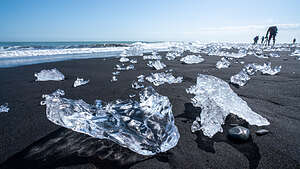 Diamond BeachSome of them were a little blue and a little white, like a peppermint candy.
Diamond BeachSome of them were a little blue and a little white, like a peppermint candy.
As we continued our stroll, Paul and I spotted a piece of ice floating right near the shoreline. We had been lamenting the lack of ice cubes for our cocktails, so we sort of jokingly said that we should capture it. This little chunk of ice was just asking for it.
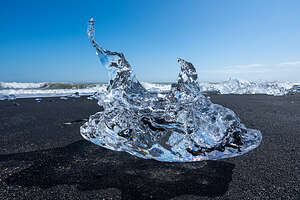 Diamond BeachSo, I ran to the van to get a plastic bag to hold it, while Paul continued to coax it in and lay it on the sand. I’m sure It was quite an entertaining sight to see us giddily wrestle it into the bag. We were quite proud of ourselves.
Diamond BeachSo, I ran to the van to get a plastic bag to hold it, while Paul continued to coax it in and lay it on the sand. I’m sure It was quite an entertaining sight to see us giddily wrestle it into the bag. We were quite proud of ourselves.
After our walk along the lagoon, we drove across the road to the parking lot for Diamond Beach, on the ocean side of the channel.
When the waves and the tides are just right, the icebergs that float through the channel from the lagoon get broken up and washed ashore, littering the beach with glittering chunks of ice.
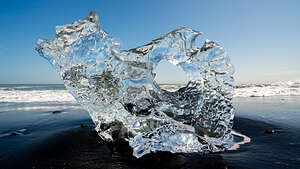 Diamond BeachHow much is on the beach at any point in time is very dependent on the tides and the power of the waves. When we first got there, there were only a few little pieces on the beach, so we decided to wait them out by taking a nap in the van. When we re-emerged about a half out later, the beach was strewn with glittering chunks of ice in all shapes and sizes.
Diamond BeachHow much is on the beach at any point in time is very dependent on the tides and the power of the waves. When we first got there, there were only a few little pieces on the beach, so we decided to wait them out by taking a nap in the van. When we re-emerged about a half out later, the beach was strewn with glittering chunks of ice in all shapes and sizes.
When we first arrived, there were only a few scattered pieces strewn across the sand. It was pretty, but not overly impressive.
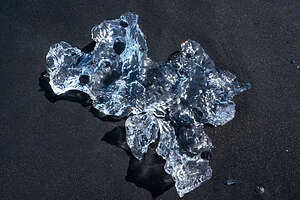 A Teddy Bear?Fortunately, we did not leave, but stayed to make lunch and take a quick nap in the vans.
A Teddy Bear?Fortunately, we did not leave, but stayed to make lunch and take a quick nap in the vans.
When we re-emerged, we were astounded. The beach was now covered with dozens and dozens of glittering ice chunks, in all shapes and sizes.
Some of them were milky white, but the most beautiful ones were perfectly clear, reminding me of my mother-in-law’s Swarovski crystal collection.
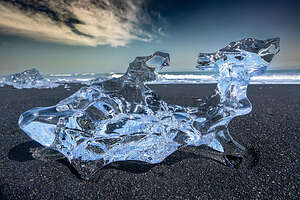 Dog or Fish?Once again, I wondered why and once again Google came through for me. Ice appears white when it contains trapped air bubbles and minerals, while clear ice has had the bubbles compressed out of it and is pure of minerals.
Dog or Fish?Once again, I wondered why and once again Google came through for me. Ice appears white when it contains trapped air bubbles and minerals, while clear ice has had the bubbles compressed out of it and is pure of minerals.
Wandering amongst them was like playing the cloud shape game I used to play as a kid, except with 1,000 year old pieces of icebergs rather than clouds.
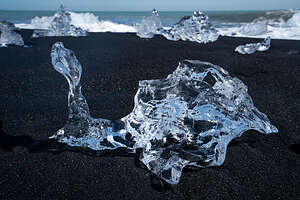 Turtle?One looked like a long-necked turtle, like the kind I saw in the Galapagos. Another one looked like a teddy bear dropped in the sand. One looked like a dog from one side and a fish from the other, so we called it a dogfish.
Turtle?One looked like a long-necked turtle, like the kind I saw in the Galapagos. Another one looked like a teddy bear dropped in the sand. One looked like a dog from one side and a fish from the other, so we called it a dogfish.
I found Herb stalking an ice lizard with his camera.
It was incredible. My only advice is that if you have the time, have patience, and wait for the ice show to begin.
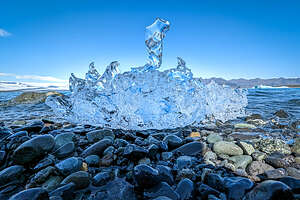 Diamond BeachDiamond Beach was pretty much the last of the highly-visited tourist spots we would see in awhile, aw we were getting out of reach of the Reykjavik tour buses. In another hour or so we would arrive at our final destination for the day - the beautiful Vestrahorn mountain in the southeast corner of Iceland.
Diamond BeachDiamond Beach was pretty much the last of the highly-visited tourist spots we would see in awhile, aw we were getting out of reach of the Reykjavik tour buses. In another hour or so we would arrive at our final destination for the day - the beautiful Vestrahorn mountain in the southeast corner of Iceland.
After that, we would start heading north along the much less traveled eastern coast - zigging in and out amongst the fjords. For the next 10 days, we would pretty much leave the crowds behind and experience a bit more of what Iceland was like before becoming a major tourist attraction. .
Múlagljúfur Canyon
Saturday, June 3, 2023 - 10:15am by Lolo17 miles and 0.5 hours from our last stop
Travelogue
 Hiking up Múlagljúfur with Vatnajökull behindDuring my pre-trip research, I came across a supposedly “hidden gem” along the southern portion of the Ring Road called the Múlagljúfur Canyon. Obviously Justin Bieber had not included it in his music video, or it definitely would not still be hidden.
Hiking up Múlagljúfur with Vatnajökull behindDuring my pre-trip research, I came across a supposedly “hidden gem” along the southern portion of the Ring Road called the Múlagljúfur Canyon. Obviously Justin Bieber had not included it in his music video, or it definitely would not still be hidden.
Múl means mule and gljúfur means canyon. Hence, "Múlagljúfur” means Mules Canyon, so I added two more Icelandic words to my vocabulary today. I am practically fluent and it's only day 3 on the Ring Road.
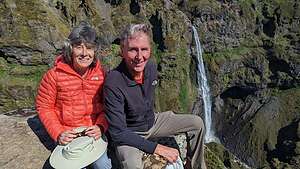 Hangandifoss viewpointAccording to the directions, unlike every other place of interest along the Ring Road, the turnoff to this canyon was not signed out. Hmm…maybe it could still be a hidden gem. Before leaving home, we marked the turnoff on Google Maps.
Hangandifoss viewpointAccording to the directions, unlike every other place of interest along the Ring Road, the turnoff to this canyon was not signed out. Hmm…maybe it could still be a hidden gem. Before leaving home, we marked the turnoff on Google Maps.
The drive to the trailhead off the Ring Road was a bumpy gravel road, but turned out to be very doable, even in a camper van.
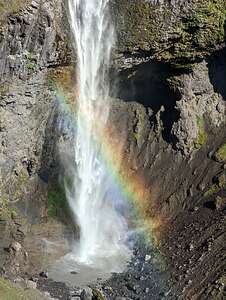 Rainbow over HangandifossThere was only one other car in the parking lot, so this was promising.
Rainbow over HangandifossThere was only one other car in the parking lot, so this was promising.
From the parking lot at the mouth of the canyon, we began hiking up into the canyon, with views of the Vatnajökull glacier behind us all the way.
After about a mile and a half we came to a lovely view of Hangandifoss, one of the tallest waterfalls in Iceland. Its source is the Múlaa River, which is fed by the melting water of the Öræfajökull (glacier), an ice-covered volcano at the southern extremity of the Vatnajökull glacier
Of course, there was a beautiful rainbow in its spray. We’ve come to expect nothing less in this incredibly magic land.
From there we hiked back down from whence we came. We only saw about 5 people the entire time, so it is still pretty much a hidden gem. I only hope it can remain that way.
Hofskirkja
Saturday, June 3, 2023 - 8:45am by Lolo12 miles and 0.3 hours from our last stop
Travelogue
_0.thumbnail.jpg) HofskirkjaToday was our last day on the southern end of the island before we would start heading north along the much less traveled eastern coast - zigging in and out amongst the fjords. For the next 10 days, we would pretty much leave the crowds behind and experience a bit more of what Iceland was like before becoming a major tourist attraction.
HofskirkjaToday was our last day on the southern end of the island before we would start heading north along the much less traveled eastern coast - zigging in and out amongst the fjords. For the next 10 days, we would pretty much leave the crowds behind and experience a bit more of what Iceland was like before becoming a major tourist attraction.
But first, we still had a lot more to see today along the southern coast.
Our first stop of the day was at the lovely Hofskirkja church, the last of the old churches of Iceland to be built in the traditional turf style.
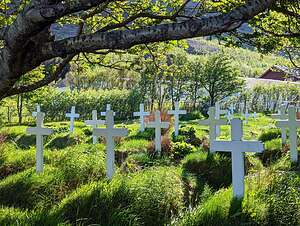 Hofskirkja cemeterySince the Vikings pretty much deforested most of Iceland over a thousand years ago, timber was in short supply, so they rather resourcefully came up with the idea of using turf instead. Not such a bad idea as it proved to be sturdier than timber in the face of storms and better at keeping the cold out. Plus they are so cute.
Hofskirkja cemeterySince the Vikings pretty much deforested most of Iceland over a thousand years ago, timber was in short supply, so they rather resourcefully came up with the idea of using turf instead. Not such a bad idea as it proved to be sturdier than timber in the face of storms and better at keeping the cold out. Plus they are so cute.
Next to the church was a peaceful little cemetery with grassy mounds adorned by simple white crosses.
As we wandered respectfully through the cemetery, I couldn’t help but notice that everyone’s name ended with the suffix -son or -dottir. A son is given his father’s first name, with the suffix -son added to it and the daughter also has the father’s first name with -dottir added to it.
Today, however, it’s perfectly acceptable to follow the matrilineal line and for children to take their mother’s first name followed by the appropriate suffix.
